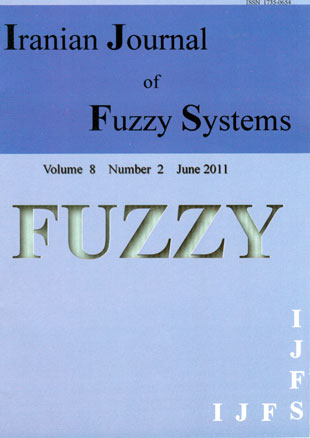فهرست مطالب

Iranian journal of fuzzy systems
Volume:8 Issue: 2, Jun 2011
- تاریخ انتشار: 1390/06/25
- تعداد عناوین: 9
-
-
Page 1The paper sets forth in detail categorically-algebraic or catalg foundations for the operations of taking the image and preimage of (fuzzy) sets called forward and backward powerset operators. Motivated by an open question of S. E. Rodabaugh, we construct a monad on the category of sets, the algebras of which generate the xed-basis forward powerset operator of L. A. Zadeh. On the next step, we provide a direct lift of the backward powerset operator using the notion of categorical biproduct. The obtained framework is readily extended to the variable-basis case, justifying the powerset theories currently popular in the fuzzy community. At the end of the paper, our general variety-based setting postulates the requirements, under which a convenient variety-based powerset theory can be developed, suitable for employment in all areas of fuzzy mathematics dealing with fuzzy powersets, including fuzzy algebra, logic and topology.
-
Page 47The acceptance sampling plan problem is an important topic in quality control and both the theory of probability and theory of fuzzy sets may be used to solve it. In this paper, we discuss the single acceptance sampling plan, when the proportion of nonconforming products is a fuzzy number. We show that the operating characteristic (OC) curve of the plan is a band having high and low bounds and that for fixed sample size and acceptance number, the width of the band depends on the ambiguity proportion parameter in the lot. When the acceptance number equals zero, this band is convex and the convexity increases with n Finally, we compare the OC bands for a given value of c.
-
Page 57In this paper, a maximum likelihood estimation and a minimum entropy estimation for the expected value and variance of normal fuzzy variable are discussed within the framework of credibility theory. As an application, a credibilistic portfolio selection model is proposed, which is an improvement over the traditional models as it only needs the predicted values on the security returns instead of their membership functions.
-
Page 67We study L-categories of lattice-valued convergence spaces. Such categories are obtained by \fuzzifying«the axioms of a lattice-valued convergence space. We give a natural example, study initial constructions and function spaces. Further we look into some L-subcategories. Finally we use this approach to quantify how close certain lattice-valued convergence spaces are to being lattice-valued topological spaces.
-
Page 91The aim of this paper is to introduce and study a new concept of strong double (A)Δ-convergent sequence of fuzzy numbers with respect to an Orlicz function and also some properties of the resulting sequence spaces of fuzzy numbers are examined. In addition, we define the double (A, Δ)-statistical convergence of fuzzy numbers and establish some connections between the spaces of strong double (A)Δ-convergent sequence and double (A, Δ)-statistical convergent sequence.
-
Page 105Using the notion of bipolar-valued fuzzy sets, the concepts of bipolar fuzzy (weak, s-weak, strong) hyper BCK-ideals are introduced, and their relations are discussed. Moreover, several related properties are investigated.
-
Page 121Abstract. In this paper, the definition of net-theoretical L-generalized convergence spaces is proposed. It is shown that, for L a frame, the category of enriched L-fuzzy topological spaces can be embedded in that of L-generalized convergence spaces as a re ective subcategory and the latter is a cartesianclosed topological category.
-
Page 133In this paper, the concept of k-regular fuzzy matrix as a general- ization of regular matrix is introduced and some basic properties of a k-regular fuzzy matrix are derived. This leads to the characterization of a matrix for which the regularity index and the index are identical. Further the relation between regular, k-regular and regularity of powers of fuzzy matrices are dis- cussed.
-
Page 143In this paper we introduce a definition of gradation of continuity in graded fuzzy topological spaces and study its various characteristic properties. The impact of the grade of continuity of mappings over the N-compactness grade is examined. Concept of gradation is also introduced in openness, closed- ness, homeomorphic properties of mappings and T2 separation axiom. E ect of the grades interrelated with N-compactness, closedness, T2 separation and homeomorphism of mappings are studied.

